The success of everything you do and want out of life all rests on a collection of muscles better known as your “core”. Yeah, seriously. You wouldn’t get very far (quite literally) if it weren’t for these muscles, and if you take the time to develop them to their maximum potential–doors open that may have been previously closed. You will get injured less often, as the core protects your spine… and here is something you may not know: it is not the ‘strength’ of your muscles that protects your back the most, but rather their ‘endurance’. And endurance is something that is incorporated into every worthy core workout (such as the one we have for you today).
And have you ever heard the phrase ‘eight-pack abs‘? They do exist for some, but you’ll need to reach deep down within every fiber of your core to find them. And you’ll also need to get on a lean body mass building regimen of food and supplements, which is something we’ve already covered with celebrity trainer, Michael Giovanni Rivera. So if you’re ready to set off in this uncharted territory to better health, less injury, improved sports performance and an overall improved physique, we have enlisted the help of Dr. Jeffrey M. Willardson. He is an Associate Professor at the Kinesiology and Sports Studies Department at the Eastern Illinoise University, and also the author of the book, Developing the Core (Human Kinetics).
Let’s get to work:
Urbasm: Jeff, your book offers a huge number of exercises to try. What would you say is a good overall introductory core program for the average armchair athlete?
Dr. Jeffrey M. Willardson: A basic program should start with a focus on developing localized endurance in the core musculature via performance of various types of planks such as in a prone, supine, or side lying position. The focus should be on maintaining proper body alignment in a static position (during different types of planks) to build a foundation for more advanced exercises that involve dynamic movement.
A beginning program might involve once daily, rotating three times through a circuit of prone, supine, and side planks (both sides) each performed for 20 seconds statically, and building up to 60 seconds over the course of four weeks.
(The following is an excerpt from Developing the Core, the latest release in the NSCA’s Sport Performance Series with Human Kinetics. All text and images provided by Human Kinetics.)
PRONE PLANK
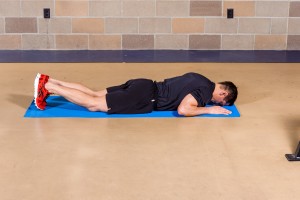 Lie on your abdomen with your palms on the floor, feet together, and spine in a neutral position. Lift your body up on your palms and toes, keeping your head, torso, and legs in a straight line.
Lie on your abdomen with your palms on the floor, feet together, and spine in a neutral position. Lift your body up on your palms and toes, keeping your head, torso, and legs in a straight line. 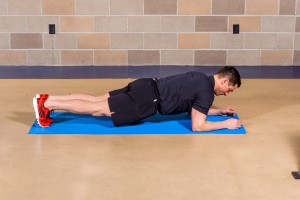 Maintain this position for the prescribed time frame, and challenge yourself to maintain longer periods in the plank position. (If you have difficulty with this exercise, place your forearms on the floor and perform as described. This is shown in the photos.)
Maintain this position for the prescribed time frame, and challenge yourself to maintain longer periods in the plank position. (If you have difficulty with this exercise, place your forearms on the floor and perform as described. This is shown in the photos.)
Variation
Prone Plank With Hip Extension: From the prone plank position, raise the heel of one foot toward the ceiling. Reducing the number of contact points increases the intensity of the exercise. Raise the heels alternately in a dynamic fashion, or hold each heel in the air for a set period of time.
SIDE BRIDGE
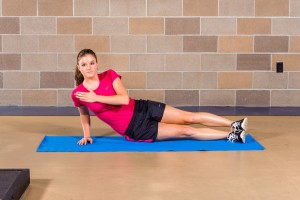 Lie on your right side, legs straight, right palm on the floor, feet stacked one on top of the other. Straighten your right arm, keeping it in line with the shoulder, and place your free hand on your opposite shoulder.
Lie on your right side, legs straight, right palm on the floor, feet stacked one on top of the other. Straighten your right arm, keeping it in line with the shoulder, and place your free hand on your opposite shoulder.  Hold this position for the desired amount of time, and then repeat on the opposite side.
Hold this position for the desired amount of time, and then repeat on the opposite side.
Variation
Modified Side Bridge (Forearm Bridge): Place your forearm on the floor, and perform the movement as described.
STABILITY BALL SUPINE BRIDGE
 Lie faceup on the floor, with hands palms-down at your sides, knees bent at a 90-degree angle, and the heels of your feet on a stability ball.
Lie faceup on the floor, with hands palms-down at your sides, knees bent at a 90-degree angle, and the heels of your feet on a stability ball. Keeping your back straight, lift your hips off the floor. Your back and thighs should form a straight line at the top of the move. Contract your glutes, and then return along the same path back to the start position.
Keeping your back straight, lift your hips off the floor. Your back and thighs should form a straight line at the top of the move. Contract your glutes, and then return along the same path back to the start position.
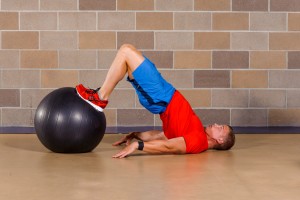 Variation
Variation
Stability Ball Supine Bridge With Leg Curl: While in the supine bridge position, flex the knees to bring the ball toward the body. Dorsiflex the feet throughout the movement to keep the heels pressed against the top surface of the ball.
Dr. JMW: After four weeks, some dynamic movements can be incorporated involving trunk flexion and extension; trunk lateral flexion and reduction; and trunk rotation; but again, taking a very conservation approach with body weight only, or 10-15 lbs added resistance. The goal might be to perform two or three sessions per week that involve two sets (of each of the aforementioned movement patterns) to the point of moderate fatigue, but never muscular exhaustion. Chapters 4 and 5 of the book would be a good place to learn different exercises and programming.
Urbasm: In your experience, where does almost every guy go wrong with his fitness regimen?
Dr. JMW: First, most guys take way too much rest between sets. For most endeavors in building musculoskeletal fitness, no more than two minutes rest should be taken between consecutive sets of the same exercise. Second, the importance of quality of repetitions rather than the quantity of repetitions should be emphasized. Doing a few sets of a given exercise with intense mental focus on the working muscles is more productive than doing more sets while “throwing” the weight with excessive momentum or poor technique.
Urbasm: How would you describe the importance of incorporating core work into a man’s regular routine? What are some of the advantages we might not be aware of?
Dr JMW: Low back pain is more often caused by a lack of muscular endurance rather than a lack of muscular strength. Furthermore, the muscles of the spine are suited for working statically in a stabilizing role rather than dynamically in a movement role. For health and functionality, the focus should be on developing fitness via different types of planks (prone, supine, side) from basic to advanced variations. For aesthetic purposes, dynamic movements (trunk flexion and extension; trunk lateral flexion and reduction; and trunk rotation) can be performed conservatively to develop a little hypertrophy in the core muscles and allow them to “show” under the skin. [Although] this is assuming that a low level of body fat is achieved in conjunction with a proper nutrition program.
Urbasm: What are the essential core exercises that every guy should be doing as a bare minimum?
Dr. JMW: The three different planks; prone, supine, and side (shown above) train muscles all the way around the torso and can be performed with several basic to advanced variations. Once a suitable level of fitness has been achieved with the planks; then more advanced exercises such as hanging knee raises, abdominal roll-outs, and cable crunches with a rope attachment can be incorporated. These are all described in Chapter 4 of the book.
(The following is an excerpt from Developing the Core.)
BARBELL ROLLOUT
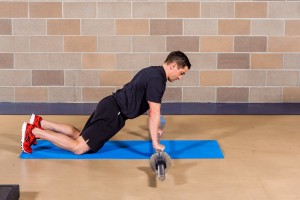 Load a pair of small plates (five-pounders work well) onto the ends of a barbell. Grasp the middle of the bar with an overhand, shoulder-width grip, and kneel down so your shoulders are directly over the bar.
Load a pair of small plates (five-pounders work well) onto the ends of a barbell. Grasp the middle of the bar with an overhand, shoulder-width grip, and kneel down so your shoulders are directly over the bar.  Your upper back should be slightly rounded, with your butt off the floor as high as possible. Keeping your knees fixed on the floor and your arms taut, roll the bar forward as far as comfortably possible without allowing your body to touch the floor. Reverse direction by forcefully contracting your abs, returning along the same path back to the start position. Repeat for the desired number of repetitions.
Your upper back should be slightly rounded, with your butt off the floor as high as possible. Keeping your knees fixed on the floor and your arms taut, roll the bar forward as far as comfortably possible without allowing your body to touch the floor. Reverse direction by forcefully contracting your abs, returning along the same path back to the start position. Repeat for the desired number of repetitions.
CABLE KNEELING ROPE CRUNCH
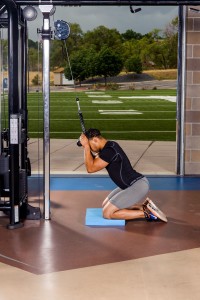 Kneel in front of a high-pulley apparatus with your body facing the machine, sitting back on your heels. Grasp the ends of a rope attached to the pulley, and keep your elbows in toward your ears, torso upright.
Kneel in front of a high-pulley apparatus with your body facing the machine, sitting back on your heels. Grasp the ends of a rope attached to the pulley, and keep your elbows in toward your ears, torso upright. 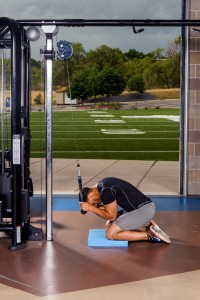 Keeping your lower back immobile, slowly curl your shoulders downward, bringing your elbows down toward your knees. Contract your abs, and then slowly uncurl your body, returning to the start position. Repeat for the desired number of repetitions.
Keeping your lower back immobile, slowly curl your shoulders downward, bringing your elbows down toward your knees. Contract your abs, and then slowly uncurl your body, returning to the start position. Repeat for the desired number of repetitions.
CABLE KNEELING TWISTING ROPE CRUNCH
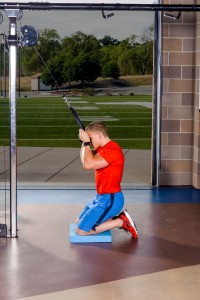 Kneel in front of a high-pulley apparatus with your body facing the machine, sitting back on your heels.
Kneel in front of a high-pulley apparatus with your body facing the machine, sitting back on your heels.  Grasp the ends of a rope attached to the pulley, and keep your elbows in toward your ears, torso upright. Keeping your lower back immobile, slowly curl your shoulders downward, twisting your body to the left as you bring your elbows toward your knees. Contract your abs, and then slowly uncurl your body, returning to the start position. Continue for the desired number of repetitions, alternating sides with each rep.
Grasp the ends of a rope attached to the pulley, and keep your elbows in toward your ears, torso upright. Keeping your lower back immobile, slowly curl your shoulders downward, twisting your body to the left as you bring your elbows toward your knees. Contract your abs, and then slowly uncurl your body, returning to the start position. Continue for the desired number of repetitions, alternating sides with each rep.
HANGING KNEE RAISE
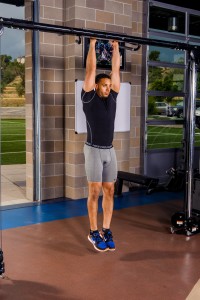 The hanging knee raise stresses the abdominals (transversus and rectus abdominis) and lower back muscles (erector spinae) to strengthen the core.
The hanging knee raise stresses the abdominals (transversus and rectus abdominis) and lower back muscles (erector spinae) to strengthen the core.  Hang from an object high enough that the body is fully extended and the feet do not touch the floor. Draw in the abdominals, slowly raise the knees to the chest, pause briefly, and then slowly lower the legs down to start position and repeat without losing the draw-in of the abdominals. The movement should be done with control so that the body does not swing. Repeat for the desired number of repetitions or for a specified amount of time (30 to 60 seconds).
Hang from an object high enough that the body is fully extended and the feet do not touch the floor. Draw in the abdominals, slowly raise the knees to the chest, pause briefly, and then slowly lower the legs down to start position and repeat without losing the draw-in of the abdominals. The movement should be done with control so that the body does not swing. Repeat for the desired number of repetitions or for a specified amount of time (30 to 60 seconds).
Variation
Hanging Straight-Leg Raise: Perform the same exercise, but keep the legs straight while raising and lowering them.
Urbasm: Jeff, What are your three best fitness tips that every man should know?
Dr. JMW:
Tip #1: Eat a consistent and healthy diet most days of the week, but do allow for some moderation in your eating habits to incorporate foods that you enjoy. Plan your day ahead of time to avoid overeating late at night.
Tip #2: Perform your exercise session early in the day when you have the most energy, rather than after work when your mind and body are fatigued.
Tip #3: Make sure to go to bed at a consistent time each day and get at least 7 hours of quality sleep per night.
And now we’ll close with a comprehensive explanation of core muscle workouts and trunk movement complexes via an excerpt from Jeff’s book, Developing the Core.
CORE MUSCLE WORKOUTS
Workouts should train the four basic movement patterns of the trunk: trunk flexion (TF), trunk extension (TE), trunk rotation (TR), trunk lateral flexion (TLF), and variations or combinations of all four. Static exercises that require trunk stabilization against these movement patterns can be used.
Note that similar muscles are used during trunk rotation and trunk lateral flexion movements. If time or training volume is a concern, the practitioner can program in such a way to include only one of these movements in a particular workout. Trunk rotation and trunk lateral flexion can be trained by alternately performing one of the two movements every other workout to ensure both are being performed in a training cycle.
The beginner or novice exerciser, with less than three months of training experience, should perform single-plane trunk movements. All exercises can be performed using body weight, with 60 seconds of rest between sets. Increase repetitions to 20 per set for dynamic exercises and 60 seconds for static exercises. Add external loading when a person can perform three to five sets of 20 repetitions of each exercise.
The exerciser with more than three months of training experience can begin to perform multiplane trunk movements. All exercises can be performed using body weight or light external loads, with 60 to 90 seconds of rest between sets. As movement proficiency and strength endurance improve, gradually increase repetitions to 20 per set for all exercises. Increase intensity when a person can perform sets of 20 repetitions of each exercise.
All four basic movement patterns can be trained by performing multiplane movements or performing single-plane and multiplane movements in the same workout.
CORE POWER WORKOUTS
The exerciser with at least four months of training experience can begin to perform power-oriented movements. To develop maximal power, nonreactive medicine ball throws can be performed for a total number of no more than five sets per exercise and one to five repetitions per set. Two to five minutes of recovery time between sets of maximal core power movements is recommended. Submaximal medicine ball reactive exercises, such as the medicine ball twisting wall toss, can be performed for a greater number of repetitions (10 to 20) for three sets per exercise and 60 to 90 seconds of recovery time between sets.
The practitioner can program in such a way to include maximal and submaximal power movements in the same workout to emphasize power in a particular movement plane. For example, assume a tennis player lacked power during an overhand serve but had decent power during rotational movements such as the backhand or forehand return. A maximal power exercise, such as nonreactive medicine ball slams, could be performed in a workout with lower-intensity core power exercises. This would help remedy the power deficiency in the movement plane that best simulates the overhand tennis serve.
TRUNK MOVEMENT COMPLEXES
The exerciser with 8 to 12 months of training experience can begin to include exercise complexes that combine trunk movement patterns with multijoint movements. Single-plane and multiplane movements can be performed using both open- and closed-chain exercises. These exercise complexes are more demanding on the body’s energy system and provide advanced exercisers greater exercise variation during a training cycle. Fewer repetitions and more rest time between sets might be needed to accommodate the fitness and conditioning level of the exerciser. Repetition schemes of three to five per complex with rest times of two to three minutes between sets are a good start point for most exercisers. A logical progression, if the goal is to increase localized muscular endurance, would include adding more repetitions and decreasing recovery time as the exerciser adapts to the training.
Exercises should include the basic multijoint movement patterns of the human body such as pulling, pushing, squatting, and lunging. With some thought and creative programming, a practitioner could design workouts to train the entire core musculature while simultaneously training all the major movement patterns of the human body. This can be achieved using three or four exercise complexes. This saves time for in-season athletes or those interested in fitness who have a demanding schedule with a limited amount of time that can be devoted to training.
CONCLUSION
Designing a training program for the core musculature does not have to be complicated or difficult. A movement approach to program design is simple and provides the practitioner the ability to design effective and balanced programs. Functional movements of the trunk are combinations or variations of four basic movement patterns: trunk flexion, trunk extension, trunk rotation, and trunk lateral flexion. A training program should include static and dynamic exercises that require stabilization against or movement through these patterns. Any physical quality can be developed (localized muscular endurance, strength, power) by following a linear progression. Exercises progress from simple single-plane to more challenging multiplane and trunk movement complexes. A variety of open- and closed-chain exercises, using various implements to increase intensity, can be incorporated into the program to develop the movement capabilities of the core musculature. Programs and exercises can be adapted to accommodate different populations, including those with previous or existing injuries.
 Developing the Core features numerous core exercises for baseball and softball, basketball, football, golf, ice hockey, soccer, swimming, track and field, tennis, volleyball, and wrestling. The book is now available in bookstores everywhere, as well as online at HumanKinetics.com.
Developing the Core features numerous core exercises for baseball and softball, basketball, football, golf, ice hockey, soccer, swimming, track and field, tennis, volleyball, and wrestling. The book is now available in bookstores everywhere, as well as online at HumanKinetics.com.
About Dr. Eric J. Leech
Eric has written for over a decade. Then one day he created Urbasm.com, a site for every guy.
